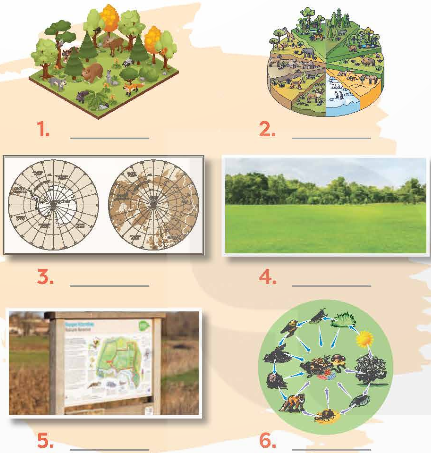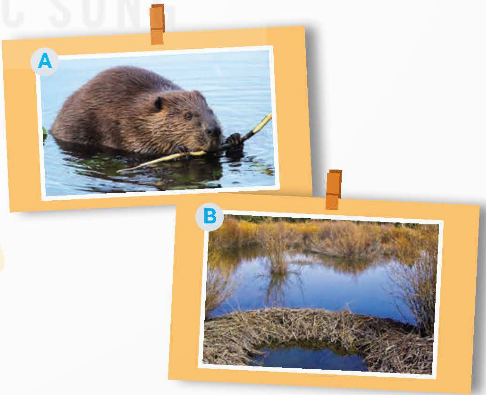Giải SGK, SBT Unit 10. Planet Earth Global Success
Giải SGK, SBT Unit 10 Global Success
2. Read the conversation again and tick (✔) T (True) or F (False) for each sentence.
(Đọc lại đoạn hội thoại và đánh dấu (✔) T (Đúng) hoặc F (Sai) cho mỗi câu.)
|
|
T |
F |
|
1. The students are asking about the Solar System. |
|
|
|
2. Another name for Earth is the Blue Planet. |
|
|
|
3. Water covers four fifths of Earth. |
|
|
|
4. Water bodies and landforms are essential habitats for plants and animals. |
|
|
|
5. Mr An thinks pollution is threatening the habitats of plants and animals. |
|
|
Vocabulary
1. Write a word or phrase from the box under each picture.
(Viết một từ hoặc cụm từ trong khung dưới mỗi bức tranh.)
|
habitats flora and fauna grassland nature reserves food chain poles |

Earth's habitats
(Môi trường sống của Trái Đất)
3. Read the short descriptions of various habitats and match them with their features.
(Đọc những mô tả ngắn gọn về các môi trường sống khác nhau và nối chúng với các đặc điểm của chúng.)
Polar habitats include the North Pole and the South Pole. These habitats are covered in ice and extremely cold and dry. Animals here include small fish, polar bears, penguins, leopard seals, etc.
Forest habitats include tropical forests, temperate forests, and boreal forests. They are considered the Earth's lungs because they produce oxygen. They also provide homes to bats, owls, deer, squirrels, foxes, lizards, etc.
Ocean habitats include the Pacific, Atlantic, Indian, Southern, and Arctic Oceans. They produce more than 50 per cent of Earth's oxygen and help adjust the climate. They provide living places for plants like sea grasses, microscopic algae, and fish, etc.
Grasslands include tropical and temperate ones. The main plants are grasses. They are crucial for grazing livestock. Grassland animals include giraffes, zebras, lions, elephants, etc.
|
1. Polar regions |
a. two main types and are crucial for livestock grazing |
|
2. Forests |
b. largest, produce oxygen and adjust the climate |
|
3. Oceans |
c. extremely cold, dry, covered in snow and ice |
|
4. Grasslands |
d. the lungs of Earth, home to many species |
3. Listen again and fill in each blank in the summary with ONE word.
(Nghe lại và điền vào mỗi chỗ trống trong phần tóm tắt MỘT từ.)
|
Effects from plants (Ảnh hưởng từ thực vật) |
- They help or (1) _______ the environment. (Chúng giúp hoặc (1) _______ môi trường.) - They make a place more beautiful. (Chúng làm cho nơi này đẹp hơn.) - They (2) _______ over the resources of local plants. (Chúng (2) _______ trên các nguồn tài nguyên thực vật địa phương.) |
|
Effects from animals (Ảnh hưởng từ động vật) |
- They can cause harm to or (3) _______ a habitat. (Chúng có thể gây hại hoặc (3) _______ môi trường sống.) - Beavers can build dams and ponds, which helps some plants and animals. (Hải ly có thể xây đập và ao hồ, giúp ích cho một số loài thực vật và động vật.) - Beavers may (4) _______ the homes of other plants and animals. (Hải ly có thể (4) _______ nhà của các loài thực vật và động vật khác.) |
|
We should (Chúng ta nên) |
- (5) _______ habitats. ((5) _______ môi trường sống.) - stop destroying forest habitats. (ngừng phá hủy môi trường sống của rừng.) - stop using (6) _______. (ngừng sử dụng (6) _______.) |
2. Complete the passage, using the words and phrases in the box.
(Hoàn thành đoạn văn bằng cách sử dụng các từ và cụm từ trong hộp.)
|
nature reserves habitat loss ecological balance food chain climate change |
Earth's habitats are various and many are threatened. Each habitat includes living things, non-living things, and the surrounding environment. The relations of all living things and their environment in a habitat make up the habitat's ecology. (1) _______ or changes in population of plants and animals can cause changes to the natural (2) _______ and the ecology. That means to maintain a(n) (3) _______, we shouldn't cause changes to the climate and the plants and animals of any habitat. In many countries, people have built (4) _______ to keep endangered plants and animals safe. People should also avoid activities that may cause pollution and (5) _______.
Grammar
3. Complete each sentence (1-5) with a non-defining relative clause (A-E).
(Hoàn thành mỗi câu (1-5) bằng mệnh đề quan hệ không xác định (A-E).)
|
A. who is considered the God of Thunder (người được coi là Thần Sấm) B. which are large and extremely dry areas (là những khu vực rộng lớn và cực kỳ khô hạn) C. whose work in geology is considered very important (có công việc về địa chất được coi là rất quan trọng) D. which is the oldest national park in Viet Nam (đó là vườn quốc gia lâu đời nhất ở Việt Nam) E. which attract many tourists worldwide (nơi thu hút nhiều khách du lịch trên toàn thế giới) |
1. The Alps are a well-known mountain range, _______.
(Dãy núi Alps là một dãy núi nổi tiếng, _______.)
2. Deserts on Earth, _______, hardly get any rain.
(Các sa mạc trên Trái Đất, _______, hầu như không có mưa.)
3. People used to believe that Thor, _______, causes storms and lightning.
(Mọi người từng tin rằng Thor, _______, gây ra bão và sét.)
4. We spent time trekking, bird-watching, and kayaking in Cuc Phuong, _______.
(Chúng tôi dành thời gian đi bộ xuyên rừng, ngắm chim và chèo thuyền kayak ở Cúc Phương, _______.)
5. James Hutton, _______, was one of the first scientists to study geology.
(James Hutton, _______, là một trong những nhà khoa học đầu tiên nghiên cứu về địa chất.)
3. a. Look at the table and match the threats to plants and animals with the suitable solutions.
(Nhìn vào bảng và nối các mối đe dọa đối với thực vật và động vật với các giải pháp phù hợp.)
|
Threats (Mối đe doạ) |
Solutions (Giải pháp) |
|
1. habitat loss (mất môi trường sống) 2. pollution (ô nhiễm) 3. climate change / global warming (biến đổi khí hậu / sự nóng lên toàn cầu) 4. hunting animals (săn bắt động vật) 5. cutting down trees (chặt cây) |
a. stopping throwing rubbish / stopping emitting toxic gases into the environment (ngừng vứt rác / ngừng thải khí độc ra môi trường) b. stopping the cutting down of trees / planting more trees (chấm dứt việc chặt cây / trồng thêm cây) c. building nature reserves (xây dựng khu bảo tồn thiên nhiên) d. punishing illegal hunters (phạt thợ săn trái phép) |
b. Read the passage again and complete the table below.
(Đọc lại đoạn văn và hoàn thành bảng dưới đây.)
|
Types of forests |
Features |
|
Rainforests or tropical forests |
- around the (1) _____ - home to insects, birds, butterflies and around (2) _____ plant species - regulate climate and provide (3) _____ |
|
Temperate forests |
- found in (4) _____ - home to (5) _____ - (6) _____ seasons - tree leaves (7) _____ colours and fall in winter |
|
Boreal forests or taiga |
- found in (8) _____ - home to (9) _____ - (10) _____ seasons |
1. Match the words and phrases with their definitions.
(Nối các từ và cụm từ với định nghĩa của chúng.)
|
1. flora and fauna |
a. a large area of water |
|
2. landform |
b. all the plants and animals in a place |
|
3. body of water |
c. a cycle explaining who eats whom in the wild |
|
4. food chain |
d. an area to protect important plants and animals |
|
5. grassland |
e. a natural shape on Earth’s surface, such as a mountain or a valley |
|
6. nature reserve |
f. a fairly flat area of grass |
2. Complete the sentences with the correct words / phrases in the box.
(Hoàn thành câu với những từ / cụm từ đúng trong khung.)
|
solar system – habitats – Pole – nature reserves – landforms |
1. Different animals and plants live in different types of _____.
2. Our _____ consists of stars, the Sun, and everything bound to it by gravity.
3. _____ can exist under water in the form of mountain ranges.
4. The South _____ is the southernmost point on Earth.
5. _____ are areas where flora and fauna are reserved and managed for conservation.





















